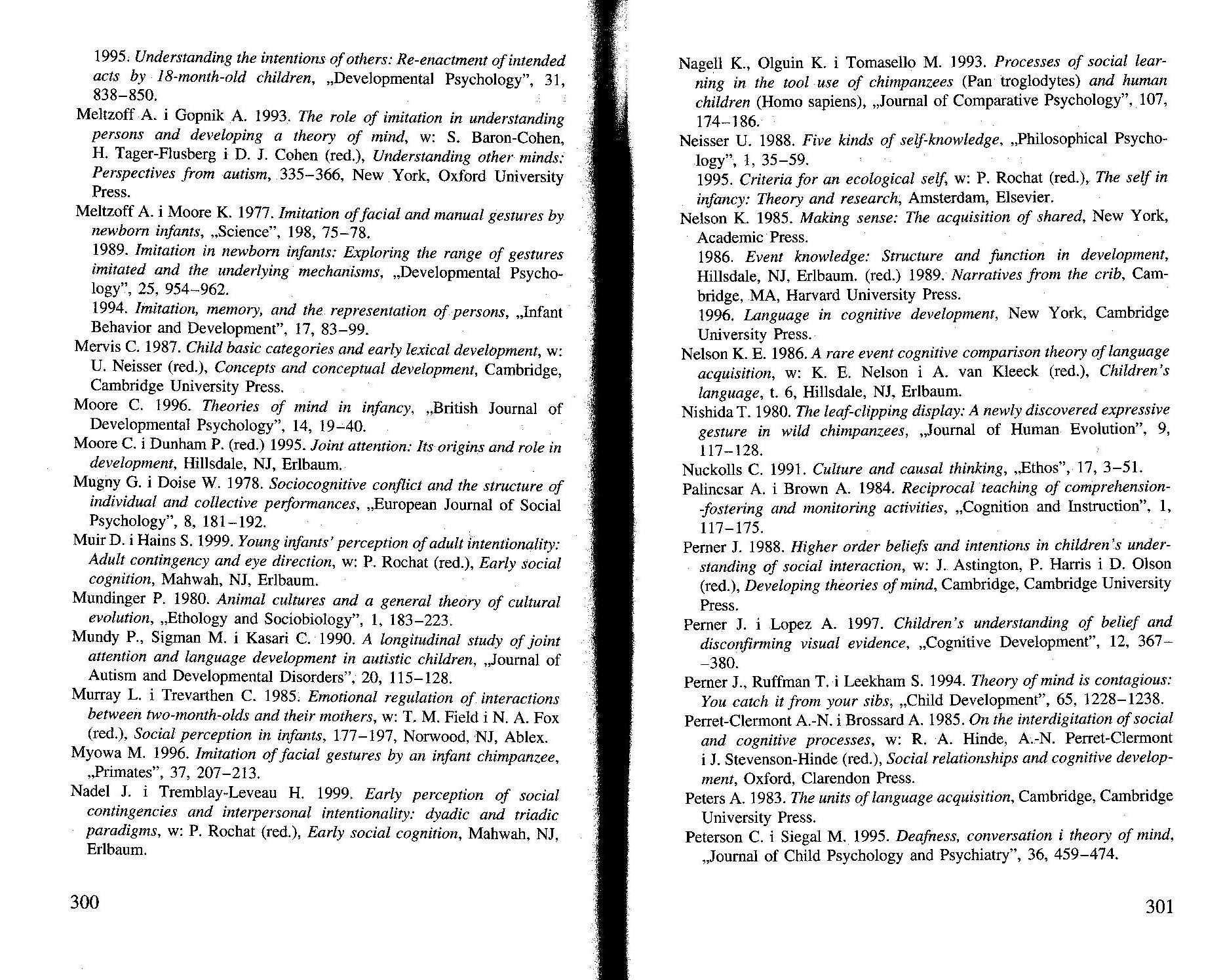CCF20090212�149

1995. Understanding the intentions of others: Re-enactment ofintended acts by 18-month-old children, „Developmental Psychology”, 31, 838-850.
Meltzoff A. i Gopnik A. 1993, The role of imitation in understanding persons and developing a theory of mind, w: S. Baron-Cohen, H. Tager-Flusberg i D. J. Cohen (red.), Understanding other minds: Perspectives from autism, 335-366, New York, Oxford University Press.
Meltzoff A. i Moore K. 1977. Imitation offacial and manuał gestures by newbom infants, „Science”, 198, 75-78.
1989. Imitation in newbom infants: Exploring the rangę of gestures imitated and the underlying mechanisms, „Developmental Psychology”, 25, 954-962.
1994. Imitation, memory, and the representation of persons, „Infant Behavior and Development”, 17, 83-99.
Mervis C. 1987. Child basie categories and early lexical development, w: U. Neisser (red.), Concepts and conceptual development, Cambridge, Cambridge University Press.
Moore C. 1996. Theories of mind in infancy, „British Journal of Developmental Psychology”, 14, 19-40.
Moore C. i Dunham P. (red.) 1995. Joint attention: Its origins and role in development, Hillsdale, NJ, Erlbaum.
Mugny G. i Doise W. 1978. Sociocognitive conflict and the structure of individual and collective performances, „European Journal of Social Psychology”, 8, 181-192.
Muir D. i Hains S. 1999. Young infants’ perception of adult intentionality: Adult contingency and eye direcłion, w: P. Rochat (red.), Early social cognition, Mahwah, NJ, Erlbaum.
Mundinger P. 1980. Animal cultures and a generał theory of cultural evolution, „Ethology and Sociobiology”, 1, 183-223.
Mundy P., Sigman M. i Kasari C. 1990. A longitudinal study of joint attention and language development in autistic children, „Journal of Autism and Developmental Disorders”, 20, 115-128.
Murray L. i Trevaithen C. 1985. Emotional regulation of interactions between two-month-olds and their mothers, w: T, M. Field i N. A. Fox (red.), Social perception in infants, 177-197, Norwood, NJ, Ablex.
Myowa M. 1996. Imitation offacial gestures by an infant chimpanzee, „Primates”, 37, 207-213.
Nadel J. i Tremblay-Leveau H. 1999. Early perception of social contingencies and interpersonal intentionality: dyadic and triadic paradigms, w: P. Rochat (red.), Early social cognition, Mahwah, NJ, Erlbaum.
Nagelł K., Olguin K. i Tomasello M. 1993. Processes of social lear-ning in the tool use of chimpanzees (Pan troglodytes) and human children (Homo sapiens), „Journal of Comparative Psychology”, 107, 174-186.
Neisser U. 1988. Five kinds of self-knowledge, „Philosophical Psychology”, 1, 35-59.
1995. Criteria for an ecological self, w: P. Rochat (red.), The self in infancy: Theory and research, Amsterdam, Elsevier.
Nelson K. 1985. Making sense: The acąuisition of shared, New York, Academic Press.
1986. Event knowledge: Structure and function in development, Hillsdale, NJ, Erlbaum. (red.) 1989: Narratives from the crib, Cambridge, MA, Harvard University Press.
1996. Language in cognitive development, New York, Cambridge University Press.
Nelson K. E. 1986. A rare event cognitive comparison theory of language acąuisition, w: K. E. Nelson i A. van Kleeck (red.), Children’s language, t. 6, Hillsdale, NJ, Erlbaum.
NishidaT. 1980. The leaf-clipping display: A newly discovered expressive gesture in wild chimpanzees, „Journal of Humań Evolution”, 9, 117-128.
Nuckolls C. 1991. Culture and causal thinking, „Ethos”, 17, 3-51.
Palincsar A. i Brown A. 1984. Reciprocal teaching of comprehension--fostering and monitoring activities, „Cognition and Instruction”, 1, 117-175.
Perner J. 1988. Higher order beliefs and intentions in children’s understanding of social interaction, w: J. Astington, P. Harris i D. Olson (red.), Developing theories of mind, Cambridge, Cambridge University Press.
Perner J. i Lopez A. 1997. Children’s understanding of belief and disconfirming visual evidence, „Cognitive Devełopment”, 12, 367--380.
Perner J., Ruffman T. i Leekham S. 1994. Theory ofmind is contagious: You catch it from your sibs, „Child Development”, 65, 1228-1238.
Perret-Clermont A.-N. i Brossard A. 1985. On the interdigitation of social and cognitive processes, w: R. A. Hinde, A.-N. Perret-Clermont i J. Stevenson-Hinde (red.), Social relationships and cognitive develop-ment, Oxford, Clarendon Press.
Peters A. 1983. The units of language acąuisition, Cambridge, Cambridge University Press.
Peterson C. i Sięgał M. 1995. Deafness, conversation i theory of mind, „Journal of Child Psychology and Psychiatry”, 36, 459-474.
301
Wyszukiwarka
Podobne podstrony:
61 The influence of waters.. so a big degree year by year. Values given by W. Szczepański and others
00318 Fc61831291a35229ea5e67ab507c8cf 321 Optimizing Defect Levels and Losses from Gage Errors Guar
History of MySQL We started out with the intention of using the mSQLdatabase system to connect to ou
Social competences: Course content PKO 1 understands the need of self-improvement P_K02 understands
ape 077 SECTION XI. THE LUNGS. It is not the intention of this work to treatconsumption or todeal wi
CCF20090212�152 1995b. Understanding the self as sociał agent, w: P. Rochat (red.), The sełf in earl
99. B.96796 THE FUTURĘ of public employee retirement systems / ed. by 01ivia S. Mi
m1360 S. Romano (1432) The Rout of San Romano has been immortalised by Uccello’s famous paintings, b
S20C 409120813070 & The Art of Exquisite Felted KnitsGiną Wilde Forcword by Yoshiko Twa m o to W
titlepage HO W TOANALYZE PEOPLE ON SIGHTTHROUGH THE SCIENCE OF HUMAŃ ANALYSISTHE FIVE HUMAŃ TYPES BY
S20C 409120813070 & The Art of Exquisite Felted KnitsGiną Wilde Forcword by Yoshiko Twa m o to W
Carrington, Lucinda The Ninety?ys of Genevieve BS Erotic jiction written by women for women &nbs
51 Annex 2.4 Page4 of 6 2000; and (III) to increase the prevalence of contraceptive use from 4.4% to
the society of the direct manuał and intellectual workers, and the treatment of human work as labor
FOREWORD The influence of emotional disorders on the treatment of aphasic patients is interestingly
więcej podobnych podstron